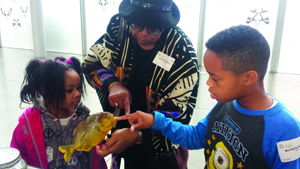/nemeth_new_240x187.tmb-thumbnail.jpg?sfvrsn=19fda458_1) I am pleased to welcome you to the second installment of Sigma Xi Speaks! This initiative provides you with policy-relevant information generated by the Society’s communications and publications staff. Sigma Xi Speaks is distributed on a regular basis to ensure that you have the most up-to-date facts and figures. I want to urge readers to pass the links (or even copy the articles) to family and friends through their social medium of choice. Let us know how you shared it and stay tuned.
I am pleased to welcome you to the second installment of Sigma Xi Speaks! This initiative provides you with policy-relevant information generated by the Society’s communications and publications staff. Sigma Xi Speaks is distributed on a regular basis to ensure that you have the most up-to-date facts and figures. I want to urge readers to pass the links (or even copy the articles) to family and friends through their social medium of choice. Let us know how you shared it and stay tuned.
First, I’d like to draw your attention to the recent publication of the areas of consensus and debate results from last year's Communicating Science for Policy conference. In August 2015, Sigma Xi and Institute on Science for Global Policy coordinated this event, which focused on linking scientifically credible information to the formulation and implementation of sound, effective policies.
The conference organizers and participants identified three main areas of consensus:
-
Publicly funded organizations have a responsibility to report the results of scientific research in a meaningful manner to nonexperts (i.e., the public or policy makers) in a timely and accessible format, using nontechnical language and having relevance to the audience’s respective lifestyles and policy decisions.
-
Storytelling is a valid and credible method of communicating science. The storyteller needs to deliver an accurate, transparent, and ethical interpretation of the scientific data.
-
Efforts must be made to improve public literacy concerning science by (i) training individuals in how to effectively communicate scientific information and (ii) teaching individuals how to more rationally evaluate the validity and relevance of the scientific information conveyed.
The March–April 2016 issue of American Scientist includes research and insights on three major topics—the effects of a changing climate on forestry, agriculture, gardening, tourism, and ecology; the increase in production and use of nanoparticles; and the recruitment and retention of underrepresented minorities in science, technology, engineering, or mathematics (STEM).
In the article, “Spring Budburst in a Changing Climate,” (Mar–Apr 2016, pages 102–109) authors Richard Primack and Amanda Gallinat describe the challenges we face as climate change causes leaf emergence times to desynchronize from evolved bird and insect activity patterns. Researchers at botanical gardens around the world are collectively monitoring leafing out times to understand this heretofore under-appreciated aspect of natural history, so that we can make better predictions about forest ecosystems as the climate changes. The forthcoming changes will affect a number of key industries, including forestry, agriculture, and tourism.
A Spotlight interview (Mar–Apr 2016, pages 70–72) with research chemist Bryant Nelson illuminates emerging issues related to the regulation of the booming nanoparticle production industry. Managing Editor Fenella Saunders spoke to Nelson about the possibility that nanoparticles may cause genetic damage. Nelson said that we need new methods and technologies to be able to detect and discriminate between the different types of nanomaterials that are potentially entering the environment.
 In the article, “How to Recruit and Retain Underrepresented Minorities” (Mar–Apr 2016, pages 76–81) Ashanti Johnson and Melanie Harrison Okoro share their experiences creating programs to attract people of color into marine science. Johnson, the assistant vice provost for faculty recruitment and associate professor of environmental science for the University of Texas at Arlington, and recipient of the Presidential Award for Excellence in Science, Mathematics, and Engineering Mentoring, and Okoro, a NOAA water quality specialist and Johnson’s former mentee, provide details about what works to attract and retain students, while emphasizing the need for additional resources to support underrepresented minorities in research.
In the article, “How to Recruit and Retain Underrepresented Minorities” (Mar–Apr 2016, pages 76–81) Ashanti Johnson and Melanie Harrison Okoro share their experiences creating programs to attract people of color into marine science. Johnson, the assistant vice provost for faculty recruitment and associate professor of environmental science for the University of Texas at Arlington, and recipient of the Presidential Award for Excellence in Science, Mathematics, and Engineering Mentoring, and Okoro, a NOAA water quality specialist and Johnson’s former mentee, provide details about what works to attract and retain students, while emphasizing the need for additional resources to support underrepresented minorities in research.
We hope you will use these resources to advance your science policy efforts. And let us know if you are looking for information about a particular policy issue.
Sincerely,

John C. Nemeth, PhD
Sigma Xi Executive Director and CEO